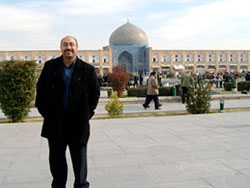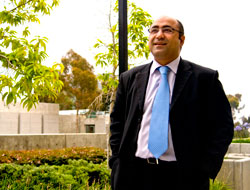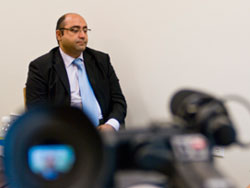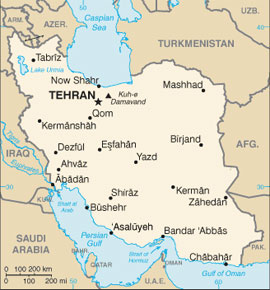Turmoil in Tehran
UCSD Professor Witnesses Aftermath of Contested Elections in Iran
Ioana Patringenaru | July 13, 2009
Every night for the past month, UCSD professor Babak Rahimi had stayed awake in his Tehran apartment, listening as residents of the Iranian capital cried out their frustration on the city’s rooftops. They shouted “Down with the dictator” and “God is great.” They were protesting the results of the June 12 election that officially gave President Mahmoud Ahmadinejad another term in office. Rahimi decided that the rest of the world needed to hear his neighbors’ voices too.
He wrote accounts of the elections’ aftermath for high-profile news organizations, including The New York Times and Los Angeles Times. He was interviewed on CNN and NPR. He was widely quoted in news stories.
As an Islamic Studies scholar, Rahimi said he not only felt the obligation to document the uprising that followed the June elections; he also felt the need to tell the world what he saw. This was a once-in-a-lifetime situation when his research, his life and the news converged.
“Usually, we academics are known to be people that detach ourselves from our work,” he said. “In these rare instances, we become our work.”
Rahimi is a prime example of UCSD’s commitment to reaching out and educating the public, said Don Wayne, outgoing chair of the department of literature, home to UCSD’s religious studies program.

Babak Rahimi poses in front of the Shah Mosque in Isfahan, Iran.
“Babak is one of the most active of our faculty in terms of outreach,” Wayne said. “[He] has really been trying to explain that there are finer distinctions within Iran’s clerical establishment.”
Rahimi’s research interests are broad, Wayne explained. He has done field work in Iraq, where he has interviewed influential clerics. He has written about the Ottoman Empire. One of his major research projects examines Iran’s rulers between the 1500s and early 1700s.
For his latest book, Rahimi is studying the impact of the Internet on Iranian politics. That’s what brought him to Iran three months before the elections. He conducted interviews and observed rallies. For an unrelated research project, he visited the countryside and the Southern port city of Bushehr. To his surprise, he found that Ahmadinejad, the incumbent president, enjoyed less support than he had expected in these regions, he wrote in an op-ed piece.
Back in Tehran, he found Iranians fully engaged in the election. “Excited: that's the key word to describe the Iranian public," Rahimi said. Televised public debates attracted record viewership. Voter turnout promised to reach historic levels. It wasn’t obvious at that point, however, that history would be made after the vote, Rahimi said.
The elections’ aftermath

Rahimi recently returned to the United States for a few days and gave several interviews.
Rahimi woke up at 6 a.m. June 13, the day after the vote, and overheard someone on the street saying that Ahmadinejad had won. “I couldn’t believe it,” he said. So, he turned on the TV and watched as the state-controlled channel announced that the incumbent president received more than 60 percent of the vote, while Mir Hussein Moussavi, the principal opposition candidate, received about 33 percent. The results came as a shock, both to Rahimi and to many Iranians, he said.
“I just remember sitting there, baffled,” Rahimi said. “Because from what I learned the last few months, and not just from the city of Tehran, but other cities around the country, was that the Moussavi camp has definitely a huge advantage over the president.”
After the elections, once police turned on the demonstrators, Rahimi cut back on his field work. Though he didn’t attend demonstrations, he was able to speak to people who did. He got a pretty good feel for what was going on in the city, he said. At night, he stayed awake, listening to his neighbors shout slogans on the rooftops.
Childhood memories
The whole experience brought Rahimi back to his childhood, 30 years ago, when another uprising was taking place. Back then, the protesters’ target was the Shah of Iran. He was ultimately toppled by the clerics and revolutionary guards who now run the country. As a child, Rahimi remembers that protesters cried out at night too. Three years later, Rahimi’s father, who opposed the new revolutionary regime, was executed.

Rahimi answers questions for the cameras during a brief states-side stay.
“I wish he was here to see all of this,” Rahimi said. “I am, in many ways, my own father seeing this history repeating itself.”
The memory of his father’s death has made him both more daring and more worried, he said. But through it all, Rahimi has remained steadfastly analytical. Asked about the underlying forces behind the current conflict, he points to the struggle for power between two factions of Iran’s conservative establishment. One faction, which Rahimi calls the old guard, took part in the revolution 30 years ago. Some, like Moussavi, had dropped out of the political scene. Others, like Ali Akbar Hashemi Rafsanjani, the former Iranian president, stayed involved. Many have a reputation for being corrupt, both morally and financially, Rahimi said.
Forces behind the scenes
Another faction, which the UCSD researcher calls the new guard, includes President Ahmadinejad and is mostly made up of middle-aged former revolutionary guards who have become bureaucrats and state employees. “They have positioned themselves as the new face of the Islamic republic,” Rahimi said. “They want to revive the true revolutionary spirit, and they want to do away with the old guard, which they believe has basically corrupted this beautiful, pure, moral state that Ayatollah Khomeini established in 1979.”

In addition to this power struggle, there also are rifts inside the Iranian clerical establishment, Rahimi said. “Shia Islamic Iran is not monolithic,” he said. Many clerics based in the Iranian city of Qum believe that no legitimate government can hold power until the Madhi, the true messiah, comes back. “So to have a cleric come out and say ‘I am the head of the state and at the same time the most powerful political authority in the country is very much seen as a blasphemy by some of these clerics,” Rahimi said.
Earlier this month, senior pro-reform clerics cast doubt over the election results publicly, exposing this rift. Even before this challenge, it was clear these clerics were not happy with the situation. “They thought that this was an immoral act,” Rahimi said. “Many of them thought that a true Islamic state should be based on honesty.”
The future
Rahimi predicted more bloody days in the coming months. But he also said that the protests would dwindle at times. The outcome of the rebellion will depend on how opposition leaders act. It will also depend on how well the government keeps the situation under control. So far, officials have been able to keep opposition leaders cut off from their base and the protesters, Rahimi said. “What we've seen so far is that the state is willing to use some very, very hard, tough measures to quell and crush the movement,” he said.
After weeks of observing, Rahimi also was able to come to some conclusions about the subject he had originally been researching: the Internet’s impact on Iranian politics. The Internet helped create momentum for the protests, he said. But it only played an auxiliary role. One exception was the shooting of a young woman named Neda Agha-Soltan. A cell phone camera recorded her death and the footage soon found its way on social networking sites, such as YouTube and Facebook. It was then picked up by mainstream news media outlets. “In that one instant, [technology] made a huge difference,” Rahimi said.
After a few days in Southern California, Rahimi is now back in Iran. He said he plans to spend the next few months more quietly, working on his book and his research. This has been a transformative experience, he said.
“You become a different person, at the end of your research,” Rahimi said. “It’s a subjective transformation that you undergo, which is exciting, interesting, but also somewhat scary.”

|